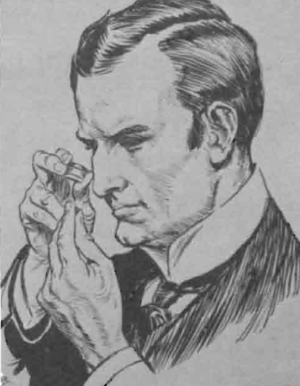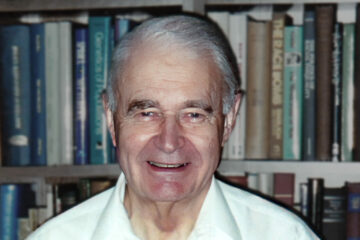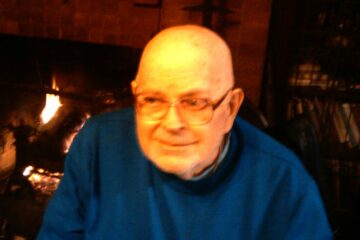Dr. Thorndyke Takes Another Bow
 DR. JOHN Evelyn Thorndyke (pictured; illustration from Pearson’s Magazine) and his creator, R. Austin Freeman, are of sufficient stature to deserve a few more words in these pages.
DR. JOHN Evelyn Thorndyke (pictured; illustration from Pearson’s Magazine) and his creator, R. Austin Freeman, are of sufficient stature to deserve a few more words in these pages.
Freeman was born in London in 1862, the son of a fashionable tailor. Having no interest in his father’s line of work, he obtained a degree in medicine. At almost the same time, as if to prove his interests were not confined to his chosen profession, he published an article in Naturalists’ World on Yorkshire moles. Lacking sufficient financial resources to set up his own medical practice, Freeman entered the Colonial Service and was posted to the Gold Coast in West Africa as a surgeon and physician. There he volunteered for an expedition organized to bring still more of the African hinterland under British control. Besides his medical duties, Freeman served as expedition botanist, zoologist, mineralogist, navigator, and diplomat. Twenty-six at the time, he described his mission in his first book Travels and Life in Ashanti and Jaman.
Prior to creating Dr. Thorndyke, Freeman wrote the Romney Pringle mysteries under the pseudonym Clifford Ashdown. Dr. Thorndyke premiered in 1907 in a work under Freeman’s real name. The character of Thorndyke was largely modeled after Dr. Alfred Swaine Taylor, founder of medical jurisprudence in Britain. The first Dr. Thorndyke story dealt with the possibility of producing a mold to construct forged fingerprints. As Deputy Medical Officer at Holloway gaol in those years, Freeman was fully acquainted with Galton’s pioneering study of dermatoglyphics.
Freeman fully espoused the classical belief that the body mirrored the mind. It was no coincidence that Dr. Thorndyke is admitted by virtually all critics to be the handsomest detective of all time. Freeman found Conan Doyle’s Sherlock Holmes distasteful because of idiosyncrasies like drug use, violin playing, and assorted histrionics. By contrast, Dr. Thorndyke is nothing if not a superhoned professional. It was this attitude which has made Thorndyke and Freeman cultural misfits in the Age of Superequality.
Freeman had a kindly paternalistic attitude toward Africans, but only contempt for the children of Israel. Jews in the Thorndyke stories are avaricious Khazars. “The Missing Mortgagee” had as its hero Elton, a starving artist who, while walking across the Margate esplanade, encounters a rain-drenched moneylender, Solomon Gordon. Here’s how Freeman describes the meeting:
Elton looked askance at the vampire by his side, at the plump, blue-shaven cheeks, the thick black eyebrows, the drooping nose and the full, red lips that embraced the cigar. Though he was a mild-tempered man he felt that he could have battered that sensual, complacent face out of all human likeness with something uncommonly like enjoyment [Shades of Der Stuermer!].
Despite his feelings Elton offers Gordon a set of his clothes, so when a less humane mortgagee meets the usurer and pushes him off a cliff, Elton is thought to be the victim. Freeman seems to sympathize with the murderer, for we are told that Gordon’s desire was for “money first, for its own sake, and then those coarser and more primitive gratifications that it was capable of purchasing.”

Biographer Norman Donaldson’s In Search of Dr. Thorndyke (Bowling Green University Popular Press, 1971) attributes Freeman’s attitude to the competition between his father’s West End custom tailoring establishment and the East End sweatshops run almost entirely by the Chosen, though Donaldson does admit that the machine shops did not produce garments of the cut and quality of the hand-sewn West End garments. He also notes that, Marxist rhetoric notwithstanding, while the owners of the sweatshops were Jews, virtually all the employees were the non-unionized poor, most of them underaged English girls. As a matter of fact, a Royal Commission was appointed in the 1880s to investigate Britain’s rapacious garment trade.
“Percival Bland’s Proxy” involves an insurance swindle in which a man named Bland fakes his death by burning his house down, after first planting a skeleton in the house to suggest that he was incinerated during a drunken stupor. Bland is found out, however, when Dr. Thorndyke discovers (by anthropological techniques which would probably be condemned as racist today) that the skeleton was the remains of a Negress. Interestingly enough, the volume containing “The Missing Mortgagee” and “Percival Bland’s Proxy” never appeared in the U.S. Though published in 1918, they were omitted from the 1932 Dodd Mead collection of Thorndyke mysteries. They were included, however, in the 1927 British Hodder and Stoughton collection.
Freeman was a frequent contributor to the Eugenics Review, where he reviewed works by J.B.S. Haldane, Bertrand Russell, and Havelock Ellis. Ellis wrote an introduction to Freeman’s Social Decay and Regeneration (1921), a plea for environmental preservation and eugenics. In “The Sub-Man” (1923) Freeman referred to the lower mean IQ scores obtained by American Blacks in Army World War I induction tests. This led him to comment on the absence from the historical scene of any indigenous Black African civilization.
Freeman’s last years were spent corresponding with his friend Ronald Jessup, who was excavating an Early Iron Age earthwork in the Epping Forest. Too ill to visit the site in person, Freeman studied Jessup’s maps, photographs, and verbal descriptions. He incorporated some of this material in his last story “The Jacob Street Mystery.”
Freeman died on September 28, 1943. Both the BBC and Thames Television’s Rivals of Sherlock Holmes series have brought Dr. Thorndyke to the cathode ray tube. Readers will have little trouble guessing which Thorndyke mysteries have not yet been videoed.
* * *
Source: based on an article in Instauration magazine, April 1978





